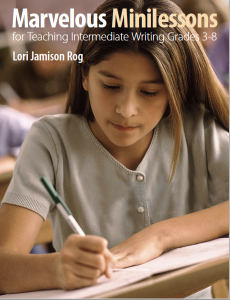Writing a Research Report
Marvelous Minilessons for Teaching Intermediate Writing by Lori Jamison Rog, Pembroke Publishers, 2018.
Researching and reporting have always been ubiquitous assignments in intermediate classrooms, and never more than today, when inquiry-based learning is playing an increasingly important role in our curricula. While the five-paragraph essay may have gone the way of the dinosaur, there is still a need for skills of searching, sifting and sorting information and communicating that information in clear and coherent written form. Teachers might choose to have students present their learning in a range of multimedia formats, but the traditional research report, with carefully selected facts, logical organization, complete sentences and conventional spelling, still holds a revered place in the worlds of college and career.
There are few places where the relationship between reading and writing is more evident than in accessing informational text. Informational writing structures help students organize their thinking in ways that are different from narrative story structures. Students must read in order to gather information for writing. They need to mentally sift and sort to select the information that is relevant to their purposes. They must learn the unique structures of informational text, negotiating not just the print but also the visuals, such as pictures, charts, tables, and graphs. And they need to use organizers, such as tables of contents, indexes, and glossaries. At the same time that students are creating informational text, they are improving their ability to read it.
STEPS IN TEACHING AN INFORMATIONAL WRITING UNIT
1. Analyze examples of the text form.
- What do you notice about the topic and details?
- What do you notice about how the paragraphs are organized?
- What do you notice about the opening and closing?
- What do you notice about the personality, tone and style of the piece?
- What writer’s techniques or special words did the writer use?
2. Choose a topic and focus it.
Choosing a topic isn’t difficult. Deciding what matters about this topic is a little harder. A common problem for many writers is choosing topics that are too broad. “All About Spiders” might be a great topic for a first-grader, but, in upper-level writing, it tends to get unwieldy, unfocused and uninteresting. We want more than a laundry list of facts on a general topic; we want to know: What’s your point? What makes this topic interesting?
3. Determine research questions or subtopics.
Zero in on two or three subtopics to research. Some writers might have just two subtopics and others might have five or six; it really depends on the topic. We often add the ubiquitous “Other Interesting Facts” for information that doesn’t fit into our subtopics, but we just might find a place for it somewhere. Identifying subtopics helps writers organize their ideas and avoid rambling on with a collection of random facts that are tied together loosely, if at all.
How do we teach students to avoid plagiarism in this “cut-and-paste” generation? Take them back to old-fashioned “jot notes” by identifying key words and ideas.
4. Transform the notes into a draft with sentences and paragraphs.
When the writer is satisfied that she has collected enough information, she’s ready to transform those notes into connected text; what we call the “first draft.” The great advantage to the gathering grid is that the information is already organized by subtopic.
5. Craft opening and closing (“bookend”) paragraphs.
The opening paragraph should grab the reader’s attention and make him want to read more. The ending usually summarizes or reiterates the main point, sort of an “all in all” statement.
6. Revise for clarity and craft.
When the rough draft is done, it’s time to re-view the text and revise it for power and effect. It’s always important to start by making sure that the content makes sense and all the pertinent information is in place. Informational writing, like all writing, should have a flare and style that speaks to a reader. Amazing facts, quotes, questions, comparisons and anecdotes are just some of the “Gems that Makes Writing Sparkle.”
7. Polish to publish.
Before any piece of writing is taken to publication, we must get out that editing cloth and polish up the conventions. You will want to build minilessons on spelling patterns, punctuation, capitalization, subject–verb agreement, etc. into this unit.
Most informational text today is full of photographs and other visuals. You might want to offer additional minilessons about how to organize a word-processed page, how to find and insert visuals, and how to create organizers such as a Table of Contents, Index, Bibliography and definitions.
Ultimately, what we want is for our students to build long-term strategies for choosing relevant topics, collecting data, and sharing what they’ve learned in text that is interesting and engaging for a reader. Carefully planned lessons that demonstrate the processes of informational writing are the best antidote for pirated papers and tired text.


